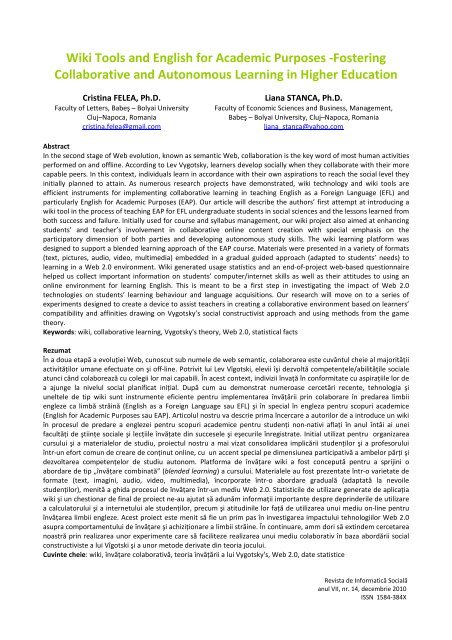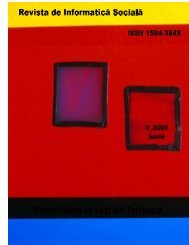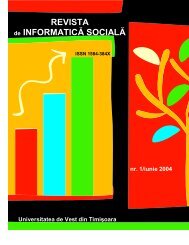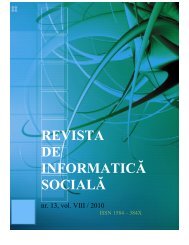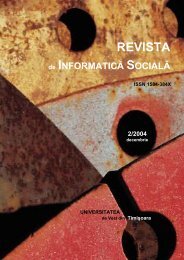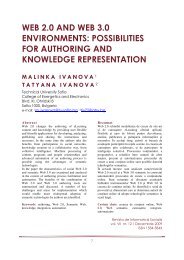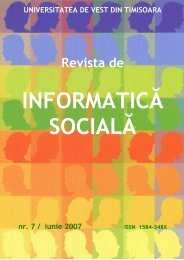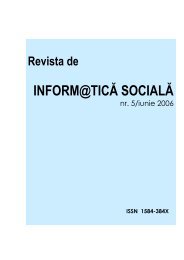Download - Journal of Social Informatics / Revista de Informatica ...
Download - Journal of Social Informatics / Revista de Informatica ...
Download - Journal of Social Informatics / Revista de Informatica ...
You also want an ePaper? Increase the reach of your titles
YUMPU automatically turns print PDFs into web optimized ePapers that Google loves.
Wiki Tools and English for Aca<strong>de</strong>mic Purposes -Fostering<br />
Collaborative and Autonomous Learning in Higher Education<br />
Cristina FELEA, Ph.D.<br />
Faculty <strong>of</strong> Letters, Babeş – Bolyai University<br />
Cluj–Napoca, Romania<br />
cristina.felea@gmail.com<br />
Liana STANCA, Ph.D.<br />
Faculty <strong>of</strong> Economic Sciences and Business, Management,<br />
Babeş – Bolyai University, Cluj–Napoca, Romania<br />
liana_stanca@yahoo.com<br />
Abstract<br />
In the second stage <strong>of</strong> Web evolution, known as semantic Web, collaboration is the key word <strong>of</strong> most human activities<br />
performed on and <strong>of</strong>fline. According to Lev Vygotsky, learners <strong>de</strong>velop socially when they collaborate with their more<br />
capable peers. In this context, individuals learn in accordance with their own aspirations to reach the social level they<br />
initially planned to attain. As numerous research projects have <strong>de</strong>monstrated, wiki technology and wiki tools are<br />
efficient instruments for implementing collaborative learning in teaching English as a Foreign Language (EFL) and<br />
particularly English for Aca<strong>de</strong>mic Purposes (EAP). Our article will <strong>de</strong>scribe the authors’ first attempt at introducing a<br />
wiki tool in the process <strong>of</strong> teaching EAP for EFL un<strong>de</strong>rgraduate stu<strong>de</strong>nts in social sciences and the lessons learned from<br />
both success and failure. Initially used for course and syllabus management, our wiki project also aimed at enhancing<br />
stu<strong>de</strong>nts’ and teacher’s involvement in collaborative online content creation with special emphasis on the<br />
participatory dimension <strong>of</strong> both parties and <strong>de</strong>veloping autonomous study skills. The wiki learning platform was<br />
<strong>de</strong>signed to support a blen<strong>de</strong>d learning approach <strong>of</strong> the EAP course. Materials were presented in a variety <strong>of</strong> formats<br />
(text, pictures, audio, vi<strong>de</strong>o, multimedia) embed<strong>de</strong>d in a gradual gui<strong>de</strong>d approach (adapted to stu<strong>de</strong>nts’ needs) to<br />
learning in a Web 2.0 environment. Wiki generated usage statistics and an end-<strong>of</strong>-project web-based questionnaire<br />
helped us collect important information on stu<strong>de</strong>nts’ computer/internet skills as well as their attitu<strong>de</strong>s to using an<br />
online environment for learning English. This is meant to be a first step in investigating the impact <strong>of</strong> Web 2.0<br />
technologies on stu<strong>de</strong>nts’ learning behaviour and language acquisitions. Our research will move on to a series <strong>of</strong><br />
experiments <strong>de</strong>signed to create a <strong>de</strong>vice to assist teachers in creating a collaborative environment based on learners’<br />
compatibility and affinities drawing on Vygotsky’s social constructivist approach and using methods from the game<br />
theory.<br />
Keywords: wiki, collaborative learning, Vygotsky's theory, Web 2.0, statistical facts<br />
Rezumat<br />
În a doua etapă a evoluţiei Web, cunoscut sub numele <strong>de</strong> web semantic, colaborarea este cuvântul cheie al majorităţii<br />
activităţilor umane efectuate on şi <strong>of</strong>f-line. Potrivit lui Lev Vîgotski, elevii îşi <strong>de</strong>zvoltă competenţele/abilităţile sociale<br />
atunci când colaborează cu colegii lor mai capabili. În acest context, indivizii învaţă în conformitate cu aspiraţiile lor <strong>de</strong><br />
a ajunge la nivelul social planificat iniţial. După cum au <strong>de</strong>monstrat numeroase cercetări recente, tehnologia şi<br />
uneltele <strong>de</strong> tip wiki sunt instrumente eficiente pentru implementarea învăţării prin colaborare în predarea limbii<br />
engleze ca limbă străină (English as a Foreign Language sau EFL) şi în special în engleza pentru scopuri aca<strong>de</strong>mice<br />
(English for Aca<strong>de</strong>mic Purposes sau EAP). Articolul nostru va <strong>de</strong>scrie prima încercare a autorilor <strong>de</strong> a introduce un wiki<br />
în procesul <strong>de</strong> predare a englezei pentru scopuri aca<strong>de</strong>mice pentru stu<strong>de</strong>nţi non-nativi aflaţi în anul întâi ai unei<br />
facultăţi <strong>de</strong> ştiinţe sociale şi lecţiile învăţate din succesele şi eşecurile înregistrate. Initial utilizat pentru organizarea<br />
cursului şi a materialelor <strong>de</strong> studiu, proiectul nostru a mai vizat consolidarea implicării stu<strong>de</strong>nţilor şi a pr<strong>of</strong>esorului<br />
într-un efort comun <strong>de</strong> creare <strong>de</strong> conţinut online, cu un accent special pe dimensiunea participativă a ambelor părţi şi<br />
<strong>de</strong>zvoltarea competenţelor <strong>de</strong> studiu autonom. Platforma <strong>de</strong> învăţare wiki a fost concepută pentru a sprijini o<br />
abordare <strong>de</strong> tip „învăţare combinată” (blen<strong>de</strong>d learning) a cursului. Materialele au fost prezentate într-o varietate <strong>de</strong><br />
formate (text, imagini, audio, vi<strong>de</strong>o, multimedia), încorporate într-o abordare graduală (adaptată la nevoile<br />
stu<strong>de</strong>nţilor), menită a ghida procesul <strong>de</strong> învăţare într-un mediu Web 2.0. Statisticile <strong>de</strong> utilizare generate <strong>de</strong> aplicaţia<br />
wiki şi un chestionar <strong>de</strong> final <strong>de</strong> proiect ne-au ajutat să adunăm informaţii importante <strong>de</strong>spre <strong>de</strong>prin<strong>de</strong>rile <strong>de</strong> utilizare<br />
a calculatorului şi a internetului ale stu<strong>de</strong>nţilor, precum şi atitudinile lor faţă <strong>de</strong> utilizarea unui mediu on-line pentru<br />
învăţarea limbii engleze. Acest proiect este menit să fie un prim pas în investigarea impactului tehnologiilor Web 2.0<br />
asupra comportamentului <strong>de</strong> învăţare şi achiziţionare a limbii străine. În continuare, amm dori să extin<strong>de</strong>m cercetarea<br />
noastră prin realizarea unor experimente care să faciliteze realizarea unui mediu colaborativ în baza abordării social<br />
constructiviste a lui Vîgotski şi a unor meto<strong>de</strong> <strong>de</strong>rivate din teoria jocului.<br />
Cuvinte cheie: wiki, învăţare colaborativă, teoria învăţării a lui Vygotsky's, Web 2.0, date statistice<br />
<strong>Revista</strong> <strong>de</strong> Informatică <strong>Social</strong>ă<br />
anul VII, nr. 14, <strong>de</strong>cembrie 2010<br />
ISSN 1584-384X
1. WIKI AS A TOOL FOR LEARNING ENGLISH<br />
1.1. General Background<br />
Due to the large circulation <strong>of</strong> English for communication in most domains, interest for teaching /<br />
learning English as a Foreign Language is extremely high. Of late, a series <strong>of</strong> surveys have focussed<br />
on the impact <strong>of</strong> social media tools on the learning <strong>of</strong> English. For instance, Schwartz reports<br />
(Schwartz, 2003) that wikis have been successfully implemented by 24 universities in Canada, UK,<br />
USA, New Zealand, and Germany for distance learning programmes in applied disciplines.<br />
However, for the purposes <strong>of</strong> this research, we have examined only European projects that have<br />
introduced social media tools for the learning <strong>of</strong> the English language in a European Union member<br />
country. Exten<strong>de</strong>d information is provi<strong>de</strong>d in the Study on the impact <strong>of</strong> information and<br />
communication technology (ICT) and new media on language learning, which was conducted<br />
between June 2008 and May 2009 (Resnick, 1991). Its main goal was to i<strong>de</strong>ntify trends,<br />
opportunities and practices beyond schools and universities, in pr<strong>of</strong>essional / working and personal<br />
life, including the use <strong>of</strong> ICT and new media in formal, non-formal and informal language learning.<br />
The participant countries were the UK, Greece, Cyprus, Finland, Spain, Hungary, France and<br />
Germany. The report emphasises that learning takes place in an environment conducive to learners’<br />
critically evaluating the usefulness <strong>of</strong> the learning material and <strong>de</strong>termining its potential value for<br />
their personal and pr<strong>of</strong>essional life. Actually, recommendations formulated by the authors <strong>of</strong> the<br />
report concern the best options for qualitatively and quantitatively optimum learning methods in<br />
relation to time resources and personal aspirations. Besi<strong>de</strong>s cost and age limitations as to the use <strong>of</strong><br />
ICT in language learning, the survey highlighted another interesting barrier, this time related to<br />
attitu<strong>de</strong>, namely for most subjects language learning is “intrinsically related to face-to-face<br />
communication and immersion in the target culture, in ‘real’ (physical) rather than ‘virtual’<br />
settings” (Resnick, 1991; Schwartz, 2003). However, while adults seem to use frequently mass<br />
media, BBC-like sites and social networks to learn non-formally and informally a foreign language,<br />
younger learners (pupils, stu<strong>de</strong>nts) have shown increased interest for Web 2.0 tools such as wikis,<br />
blogs, social bookmarking for study purposes in both formal and non-formal settings.<br />
The findings and the recommendations <strong>of</strong> this ample survey have further substantiated our <strong>de</strong>cision<br />
to introduce the wiki as learning environment based on the social constructivist premises mentioned<br />
in the introduction, where acquisition <strong>of</strong> a foreign language can be seen as the result <strong>of</strong> the<br />
collaborative effort <strong>of</strong> a community cumulated with individual en<strong>de</strong>avour.<br />
1.2. Local Context<br />
Recent data from Europe’s Digital Competitiveness Report (2009) show Romania both ranking<br />
relatively mo<strong>de</strong>stly in terms <strong>of</strong> internet usage and internet skills and having un<strong>de</strong>rgone some<br />
progress as well. Thus, as compared to 2006, Internet usage in terms <strong>of</strong> general activities has<br />
increased significantly. Yet, less than 38% <strong>of</strong> the population uses the Internet for communication,<br />
from which 19% on a daily basis and the rest at least once a week. Internet usage for educational<br />
purposes is still timid, accounting for only 3% <strong>of</strong> the users. Yet, in comparison with 2006, when 8%<br />
<strong>of</strong> the users accessed the Internet to seek information for learning purposes, in 2009, the percentage<br />
increased to 25%, which represents a significant growth if we take into account Romania’s<br />
economic situation and the <strong>de</strong>gree <strong>of</strong> Romanians’ access to technology (Preda, Stanica, Crisan,<br />
2010).<br />
In an optimistic view, we can say that Romanians’ usage <strong>of</strong> the Internet for daily activities has<br />
increased. The authors consi<strong>de</strong>r that if the increase <strong>of</strong> Internet usage in all areas continues at a<br />
similar pace with that registered in the interval 2006-2009, a significant advance will become a
eality. Besi<strong>de</strong>s being an additional incentive, these data have confirmed that our initiative to<br />
implement a collaborative learning platform was a good <strong>de</strong>cision.<br />
In Romania, the present period is <strong>de</strong>fined by attempts to change higher education into a more<br />
research and market based system as well as by the accomplishment <strong>of</strong> the transition to the more<br />
flexible Bologna system. In terms <strong>of</strong> critical competencies, early 21st century policies followed by<br />
our country state that “critical thinking, generalist (broad) competencies, ICT competencies<br />
enabling expert work, <strong>de</strong>cision-making, handling <strong>of</strong> dynamic situations, working as a member <strong>of</strong> a<br />
team, and communicating effectively” (Seitzinger, 2006) are required <strong>of</strong> active members <strong>of</strong> presentday<br />
society.<br />
Pioneering research and projects on the impact <strong>of</strong> Web 2.0 technologies in teaching/learning in<br />
Romanian secondary and higher education by our colleagues Gabriela Grosseck (West University<br />
<strong>of</strong> Timisoara), Carmen Holotescu (Polytechnic University <strong>of</strong> Timisoara), and Anisoara Pop<br />
(Dimitrie Cantemir University in Targu-Mures date back as early as 2003-2004. The results <strong>of</strong> their<br />
research in this area have been an encouragement for the authors <strong>of</strong> the present study and a sign that<br />
small steps taken in the right direction will finally cumulate in a critical mass that would <strong>de</strong>termine<br />
the long expected change, especially in terms <strong>of</strong> attitu<strong>de</strong> towards what currently is called “the<br />
learning revolution.”<br />
1.3. Language learning at tertiary level and Web 2.0 tools<br />
In language learning at tertiary level, the traditional teaching methods such as “presentationpractice-production,”<br />
followed by communicative, task-based, or project-based methods are<br />
gradually being replaced by a “post-method” stage (Harriman, 2010: pag. 78) where a prior analysis<br />
<strong>of</strong> the learning context, together with macro strategies such as maximization <strong>of</strong> learning<br />
opportunities, facilitating negotiation, fostering language awareness, promoting learner autonomy<br />
etc. (Kumaravadivelu, 2001, 2006, quoted in Harmer, 2007: pag.78) and reflective practice would<br />
ensure optimum results. This way, both teacher and stu<strong>de</strong>nts can participate in curricular and<br />
syllabus <strong>de</strong>cision, as well as in choosing the most a<strong>de</strong>quate/ efficient methods that take into account<br />
cultural, social and personal variables.<br />
Another factor to have played an important role in the change <strong>of</strong> paradigm in language teaching is<br />
the <strong>de</strong>velopment <strong>of</strong> digital literacy and <strong>of</strong> the view according to which, rather than simple assistive<br />
tools for transmission <strong>of</strong> information, technology-enhanced learning environments are conducive to<br />
higher cognitive performance. One <strong>of</strong> the foremost promoters <strong>of</strong> this paradigm shift, David H.<br />
Jonasen, claims that<br />
“Constructivist mo<strong>de</strong>ls <strong>of</strong> instruction strive to create environments where<br />
learners actively participate in the environment in ways that are inten<strong>de</strong>d to<br />
help them construct their own knowledge, rather than having the teacher<br />
interpret the world and ensure that stu<strong>de</strong>nts un<strong>de</strong>rstand the world as they<br />
have told them. In constructivist environments, like cognitive tools, learners<br />
are actively engaged in interpreting the external world and reflecting on<br />
their interpretations. This is not in the sense that learners actively<br />
listen and then mirror the one correct view <strong>of</strong> reality, but rather "active" in<br />
the sense that learners must participate and interact with the surrounding<br />
environment in or<strong>de</strong>r to create their own view <strong>of</strong> the subject”<br />
(Harriman, 2007)
Thus, the unprece<strong>de</strong>nted <strong>de</strong>velopment <strong>of</strong> collaborative technology and its successful use in<br />
language learning at tertiary level (Kommers, 1992; Kovacic, Bubas, Zlatovic, 2007a) has<br />
<strong>de</strong>termined us to make a similar attempt to implement a collaborative learning environment<br />
believing that local context adaptations in terms <strong>of</strong> motivation, time and resource constraints are<br />
necessary for ESP/EAP curricula to cater for a variety <strong>of</strong> needs pertaining to general<br />
communication, and pr<strong>of</strong>essional, social and personal <strong>de</strong>velopment. As to the role <strong>of</strong> technology,<br />
we believe in its role <strong>of</strong> “improving learner’s learning experience” and “support real world,<br />
constructivist, collaborative, problem solving learning experiences” (UNESCO, 2002).<br />
2. WIKI-BASED ENGLISH FOR ACADEMIC PURPOSES COURSE<br />
The course in English for Aca<strong>de</strong>mic Purposes for un<strong>de</strong>rgraduate first year (EFL) stu<strong>de</strong>nts enrolled<br />
at the Faculty <strong>of</strong> Sociology and <strong>Social</strong> Work <strong>of</strong> Babes-Bolyai University in Cluj-Napoca is a twosemester,<br />
two hour/week practical course. Various factors, mostly economic and cultural, have<br />
generated constraints that affect the quality <strong>of</strong> the learning process, learning outcomes and the<br />
stu<strong>de</strong>nt / teacher satisfaction. The most obvious are classes comprising more than 30 stu<strong>de</strong>nts with<br />
heterogeneous levels ranging from A1 to C1 (cf. CEFL), and low attendance. Cultural and<br />
psychological factors such as fear <strong>of</strong> change/new and low motivation are beyond the scope <strong>of</strong> our<br />
project but investigations in these areas would certainly bring light to many aspects pertaining to the<br />
learning process.<br />
The major characteristics <strong>of</strong> ESP/EAP courses i<strong>de</strong>ntified by Carver (Carver, 1983) (authentic<br />
material, purpose related-orientation and self direction) are supported by a blen<strong>de</strong>d learning<br />
approach consisting <strong>of</strong> face-to-face practical courses (teacher-driven for the input <strong>of</strong> basic concepts<br />
and gui<strong>de</strong>d practice in reading / writing / presenting for aca<strong>de</strong>mic purposes) and individual/ group<br />
assignments on wiki based resources. Authentic materials are presented in a variety <strong>of</strong> formats<br />
(audio, vi<strong>de</strong>o, multimedia) embed<strong>de</strong>d in a gradual gui<strong>de</strong>d approach (accompanied by reference links<br />
to EAP tutorials from other universities and internet-based activities tutorials adapted to stu<strong>de</strong>nts’<br />
needs) to learning in a Web 2.0 environment. The self direction assumes that learning is not<br />
incremental (learners tend to acquire the language system when they are ready, not necessarily in<br />
the or<strong>de</strong>r they are presented by teachers / course books) and there must be a systematic attempt by<br />
teachers to teach the learners how to learn by teaching them about learning strategies. The results <strong>of</strong><br />
a pre-sessional needs analysis 1 showed that stu<strong>de</strong>nts have a level <strong>of</strong> general English ranging from<br />
A2 to C1 (according to CEFL) and very little knowledge <strong>of</strong> aca<strong>de</strong>mic culture such as genres,<br />
conventions etc.<br />
Pursuant to wiki theory and the rationale mentioned in the first parts <strong>of</strong> this study, we created a web<br />
platform as extension for the blen<strong>de</strong>d learning course in English for Aca<strong>de</strong>mic Purposes. The wiki<br />
platform is based on the wiki hosting service Wikispaces because <strong>of</strong> its <strong>de</strong>ductible and user-friendly<br />
interface that requires only minimum internet skills and can be used after a basic instructional<br />
session.<br />
The structure <strong>of</strong> the wiki space allows for a work-in-progress approach to differentiated learning.<br />
1 As seen by Dudley-Evans and St John (1998: pag. 125) a flexible needs analysis should take into account “learners as<br />
people, as language users and as language learners” [Dudley-Evans, T., St. John, M.J., (1998). Developments in ESP: A<br />
multidisciplinary approach. Cambridge: Cambridge University Press].
Stu<strong>de</strong>nt<br />
Page 1<br />
Stu<strong>de</strong>nt<br />
Page n<br />
Teacher’s<br />
Page<br />
Stu<strong>de</strong>nt<br />
Page2<br />
Stu<strong>de</strong>nt<br />
Page4<br />
Stu<strong>de</strong>nt<br />
Page3<br />
Figure 1 The structure <strong>of</strong> the wiki<br />
Its structure consists <strong>of</strong> a central teacher-generated input area and n adjacent stu<strong>de</strong>nt pages, whose<br />
progress on a relatively regular basis by means <strong>of</strong> user-generated content accounts for organic<br />
growth. This makes course management accessible and flexible.<br />
The “teacher area” consists <strong>of</strong> several pages grouped according to their communicative purpose: (1)<br />
course organisation: home page with page <strong>de</strong>scriptions, course rationale and course schedule; (2)<br />
tutorials for using Web 2.0 tools and wikiquette rules; (3) course materials consisting <strong>of</strong> two<br />
modules, aca<strong>de</strong>mic reading and aca<strong>de</strong>mic writing; (4) support pages and a chat page for<br />
synchronous discussions; (5) page history and change notification for all wiki pages; (6) stu<strong>de</strong>nt<br />
page structure, membership, wiki and page permissions.<br />
Figure 2 Teacher area<br />
In the adjacent area <strong>de</strong>dicated to the stu<strong>de</strong>nts, the teacher imposed a uniform format for the stu<strong>de</strong>nt<br />
page in or<strong>de</strong>r to gui<strong>de</strong> the assimilation <strong>of</strong> the new instrument for interactive learning. This section is<br />
composed <strong>of</strong> (1) stu<strong>de</strong>nt pr<strong>of</strong>ile: name, photo, “about me” information (brief presentation<br />
(maximum 200 words): bio, interests, ways <strong>of</strong> spending leisure time - it is recommen<strong>de</strong>d that you
spice them up with vi<strong>de</strong>os, photos, your own creations, favourite music/books/movies etc, quotes,<br />
technology experience etc.), assignments; (2) synchronous (chat widget) and asynchronous (page<br />
discussion tab) communication for teacher/stu<strong>de</strong>nt feedback on current assignments and issues<br />
related to wiki activity; (3) page history and notifications.<br />
Figure 3 Stu<strong>de</strong>nt page<br />
3. WIKI-BASED ENGLISH FOR ACADEMIC PURPOSES COURSE:<br />
A FEW STATISTICAL FACTS<br />
In the first year <strong>of</strong> implementation, we focussed on finding out whether the wiki environment can<br />
foster individual work and knowledge building with a minimum (no compulsory) participation in<br />
the face-to-face course meetings. The results our study will be <strong>de</strong>scribed below.<br />
The group consisted <strong>of</strong> 38 enrolled stu<strong>de</strong>nts out <strong>of</strong> which 35 created accounts on Wikispaces and<br />
joined Socio12009 as shown in the graph:<br />
11%<br />
11%<br />
8%<br />
8%<br />
8%<br />
54%<br />
February<br />
March<br />
April<br />
May<br />
June<br />
July<br />
Figure 4 Accounts created in the interval February-July 2010 (%)<br />
The majority <strong>of</strong> the stu<strong>de</strong>nts created their accounts and joined the wiki in March (54%).
100%<br />
90%<br />
80%<br />
70%<br />
60%<br />
50%<br />
40%<br />
30%<br />
20%<br />
10%<br />
0%<br />
Aca<strong>de</strong>mic Reading<br />
Aca<strong>de</strong>mic Writing<br />
Cours rationale<br />
CV European mo<strong>de</strong>l<br />
Easy topics<br />
Citations and copyright<br />
home<br />
Food for Thought<br />
Feedback<br />
Sample Stu<strong>de</strong>nt Page<br />
Web 2.0 Tutorials<br />
Wikiquette<br />
Work Schedule<br />
Writing_Frequently …<br />
Sharing<br />
Current news<br />
Glossary<br />
July<br />
Jun<br />
May<br />
April<br />
Martie<br />
February<br />
Figure 5 Wiki page views during the interval February-July (%)<br />
The frequency <strong>of</strong> wiki page views helps to follow the dynamics <strong>of</strong> the course attendance, namely:<br />
1. in the first part <strong>of</strong> the semester (February-March) stu<strong>de</strong>nts viewed mainly pages related to<br />
course organisation, Web 2.0 technology, frequently asqued questions, wiki rules and the<br />
sample stu<strong>de</strong>nt page containing information required to build their individual pages;<br />
2. in the second part <strong>of</strong> the semester (April-May) stu<strong>de</strong>nts viewed pages with information<br />
related to course materials and assignments, namely aca<strong>de</strong>mic reading and aca<strong>de</strong>mic<br />
writing;<br />
3. finally, in June, when the exam session began, all page views increased significantly their<br />
frequency.<br />
All in all, the most visited pages in all interval were the home page, the reading and writing pages.<br />
Unfortunately, this interest was not matched by editing activities since wiki usage statistical data<br />
show low figures in terms <strong>of</strong> page edits. Out <strong>of</strong> the 35 registered members, 19 edited their allocated<br />
page whith average editing 22 per total. We consi<strong>de</strong>r this mainly a consequence <strong>of</strong> the lack <strong>of</strong><br />
feedback/interaction such as messages, which registered very low figures in both stu<strong>de</strong>nts’ and<br />
teacher’s activity. This weakness <strong>de</strong>finitely needs more attention in the future.<br />
According to the number <strong>of</strong> page views on the wiki platform, there are 3 categories <strong>of</strong> stu<strong>de</strong>nts,<br />
namely with low activity (below 15 page views), with average activity (between 15 and 30 page<br />
visits) and high activity (over 30 page visits). We applied the Kurskal-Wallis test for in<strong>de</strong>pen<strong>de</strong>nt<br />
and unequal samples. The null hypothesis <strong>of</strong> the test is that there are differences in the capacity to<br />
assimilate information among the three studied groups.<br />
In terms <strong>of</strong> wiki activities, we noticed three categories <strong>of</strong> stu<strong>de</strong>nts: low activity stu<strong>de</strong>nts (below an<br />
average <strong>of</strong> 15 views/month), medium activity stu<strong>de</strong>nts (average <strong>of</strong> page views between 15 and<br />
30/month) and high activity (more than 30 page views/month). We applied the Kurskal/Wallis test<br />
for in<strong>de</strong>pen<strong>de</strong>nt and unequal samples. The null hypothesis is that there are differences between the<br />
three categories in terms <strong>of</strong> information processing. The resulting statistical result is 27,94 based on<br />
a p value
Thus, we have tried to <strong>de</strong>termine whether there is a correlation between the views and the number<br />
<strong>of</strong> edits <strong>of</strong> each stu<strong>de</strong>nt category and for the whole sample. The result obtained and interpreted<br />
according to Colton (1974) is (DruganTigan, 2005):<br />
1. In the group that had an average <strong>of</strong> less than 15 views/ month, we calculated the Bavaris-<br />
Pearson correlation coefficient and we obtained r=0.17
200<br />
Correlation View/Page Edits<br />
150<br />
View<br />
100<br />
50<br />
0<br />
y = 4.752x + 106.1<br />
R² = 0.465<br />
0 2 4 6 8<br />
Page Edits<br />
Figure 7 The Regression Line<br />
The regression line that approximates the ten<strong>de</strong>ncy <strong>of</strong> the dot cloud is based on the<br />
equation y = 4.752x + 106, 1 and the coefficient <strong>of</strong> <strong>de</strong>termination R2 = 0.465. The trust level<br />
<strong>of</strong> this equation is good, with a coefficient <strong>of</strong> <strong>de</strong>termination <strong>of</strong> 0.465, which means that there<br />
is a correlation between the two activities for 4 users in 10 for this group.<br />
3. Within the group with a rich activity, namely more than 30 views/ month, the value <strong>of</strong> the<br />
Pearson coefficient was r=0.14
The conclusion <strong>of</strong> our statistical analysis is that the great number <strong>of</strong> stu<strong>de</strong>nts with low interest for<br />
individual study based on the wiki resources is mainly due to the low frequence <strong>of</strong> teacher<br />
feedback, low attendance <strong>of</strong> face-to-face meetings (no compulsory attendance was stipulated at the<br />
beginning <strong>of</strong> the semester) and, finally, the stu<strong>de</strong>nts’ own type <strong>of</strong> involvement in the learning<br />
activity, namely slow start and increased frequency after mid-semester and at the end-<strong>of</strong>-semester<br />
intervals, when assessment constraints became imminent.<br />
4. CONCLUSIONS<br />
Due to the transition to the semantic web where most activities are carried out un<strong>de</strong>r the sign <strong>of</strong><br />
collaboration and the results <strong>of</strong> numerous studies/ surveys attesting Web 2.0 technologies’<br />
beneficial impact on learning, we have <strong>de</strong>ci<strong>de</strong>d to introduce the wiki as a component <strong>of</strong> a blen<strong>de</strong>d<br />
learning approach to learning English for Specific/Aca<strong>de</strong>mic Purposes.<br />
Our research will continue with corrections and adaptations <strong>of</strong> the wiki platform in or<strong>de</strong>r to meet<br />
the needs <strong>of</strong> stu<strong>de</strong>nts by creating a balance <strong>of</strong> face-to-face meetings and wiki presence, a regular<br />
feedback pattern teacher-stu<strong>de</strong>nts and distributing tasks and assessment/ self-assessment activities<br />
during the semester interval.<br />
A long-term goal would be to i<strong>de</strong>ntify stu<strong>de</strong>nt pr<strong>of</strong>iles based on an interdisciplinary approach<br />
(cultural, educational, <strong>de</strong>mographic, language level dimensions) that would allow us to personalise<br />
the collaborative learning process into more efficient working groups. This would help us build a<br />
<strong>de</strong>termining/<strong>de</strong>fining pattern <strong>of</strong> relationships based on methods from the game theory that would<br />
help optimise the learning process and bring about enhanced pr<strong>of</strong>essional, social and personal<br />
results for all parties involved.<br />
REFERENCES<br />
1. Carver, D., (1983). Some propositions about ESP. In The ESP <strong>Journal</strong> no. 2, pag: 131-137.<br />
2. Constructivismul in educatie, http://inovatie.numeris.com.ro/E.Noveanu-Constructivismul.pdf.<br />
3. Digital competitiveness: http://ec.europa.eu/information_society/newsroom/cf/item-<strong>de</strong>taildae.cfm?item_id=6499<br />
4. Dillenbourg, P., Baker, M., Blaye, A., O'Malley, C., (1996). The evolution <strong>of</strong> research on<br />
collaborative learning. In E. Spada and P. Reiman (eds). (1996). Learning in Humans and<br />
Machine: Towards an interdisciplinary learning science. pag: 189-211. Oxford: Elsevier.<br />
5. Doise, W., Mugny, G., (1984). The social <strong>de</strong>velopment <strong>of</strong> the intellect. In Doise, W. and<br />
Mugny, G., (1984). Dezvoltarea socială a intelectului. Oxford: Pergamon Press. Oxford:<br />
Pergamon Press.<br />
6. Drugan, T., Achimas, A., Tigan, S., (2005). Biostatistică, Editura SRIMA, Cluj-Napoca.<br />
7. Eurostat. Information Society Statistical Data, (2009). URL: http://epp.eurostat.ec.europa.eu/<br />
portal/page/portal/information_society/data/main_tables. Accessed 22 December 2010.<br />
8. Flash Eurobarometer nr. 260, (2009). Stu<strong>de</strong>nts and Higher Education Reform, URL:<br />
http://ec.europa.eu/public_opinion/flash/fl_260_en.pdf Retrieved 10 March 2010.<br />
9. Freeman, R. E., (1984). Strategic Management: A Stakehol<strong>de</strong>r Approach. Pitman Publishing<br />
Inc., Marshfield, MA.<br />
10. Friedman, M., (1962). Capitalism and Freedom. University <strong>of</strong> Chicago Press, Chicago, IL.<br />
11. Goodsell, A., Maher, M., Tinto, V., Leigh Smith, B., MacGregor, J., (1992). What Is<br />
Collaborative Learning? in Collaborative Learning: A Sourcebook for Higher Education, The<br />
National Center on Postsecondary Teaching, Learning, and Assessment at Pennsylvania State<br />
University.<br />
12. Harmer, J., (2007). English Language Teaching, Pearson. Longman.<br />
13. Harriman, G., (2010). Learning 2.0: fad, new pedagogical, or something else?, http://www.gray<br />
harriman.com/learning2.htm. Retrieved 30 March, 2010.
14. http://eacea.ec.europa.eu/llp/studies/documents/study_impact_ict_new_media_language_learnin<br />
g/final_report_en.pdf<br />
15. Johnson, D.W., Johnson, R.T., Smith, K.A., (1998). Change, July/August, pag. 27-35.<br />
16. Jonasen, D.H., (2010). Technology as Cognitive Tools. Learners as Designers. URL:<br />
http://itech1.coe.uga.edu/itforum/paper1/paper1.html. Retrieved 31 March 2010.<br />
17. Kommers, P.A.M, Jonassen, D., Mayes, T., (Eds) (1992). Cognitive Tools for learning.<br />
Hei<strong>de</strong>lberg: Springer.<br />
18. Kovacic, A., Bubas, G., Zlatovic, M., (2007a). Evaluation <strong>of</strong> activities with a wiki system in<br />
teaching English as a second language. In International Conference ICT for Language Learning,<br />
Florence, Italy. Retrieved May 10, 2008, from: www.leonardo-lets.net/ict/common/<br />
download/AndrejaKovacic.pdf.<br />
19. Kovacic, A., Bubas, G., Zlatovic, M., (2007b). Using a wiki system for learning activities in a<br />
specialist English aca<strong>de</strong>mic course. In Proceedings on the Conference Computers in Education,<br />
30 th International Convention MIPRO 2007, Opatija, Croatia, pag. 198-203.<br />
20. Leuf, B., Cunningham, W., (2001). The wiki way: Quick collaboration on the web. Boston:<br />
Addison Wesley.<br />
21. Mattison, D., (2003). Quickiwiki, Swiki, Twiki, Zwiki and the Plone wars: Wiki as a PIM and<br />
collaborative content tool, [Electronic version]. Searcher, 11(4), pag. 32-48.<br />
22. Noveanu, E. (1999). Constructivismul in educatie. In <strong>Revista</strong> <strong>de</strong> Pedagogie, no. 7-12, pag. 7-16,<br />
http://inovatie.numeris.com.ro/E.Noveanu-Constructivismul.pdf.<br />
23. Panitz, T., Collaborative versus cooperative learning- a comparison <strong>of</strong> the two concepts which<br />
will help us un<strong>de</strong>rstand the un<strong>de</strong>rlying nature <strong>of</strong> interactive learning, http://home.capecod.net/<br />
~tpanitz/tedsarticles/coop<strong>de</strong>finition.htm.<br />
24. Preda, A.M., Stanica, J.L., Crisan, D.A., (2011). A study on the stage <strong>of</strong> e-learning <strong>de</strong>velopment<br />
in Romania. In European Integration - New Challenges, 6 th Edition 28-29 May 2010,<br />
http://anale.steconomiceuora<strong>de</strong>a.ro/volume/2010/n1/131.pdf.<br />
25. Privateer, P., (1999). Aca<strong>de</strong>mic Technology and the Future <strong>of</strong> Higher Education: Strategic Paths<br />
Taken and Not Taken. In <strong>Journal</strong> <strong>of</strong> Higher Education, 70(1), pag. 60-79 (apud. Philippa<br />
Gerbic, What About Flexible Learning And ICT? – A Review Of Technology Based Flexible<br />
Learning, In Tertiary Education. URL: http://www.col.org/pcf3/Papers/PDFs/Gerbic_Philippa<br />
.pdf . Retrieved 1 April 2010.<br />
26. Resnick, L.B., (1991). Shared cognition: thinking as social practice. In L. Resnick, J. Levine<br />
and S. Teasley (Eds). (1991). Perspectives on <strong>Social</strong>ly Shared Cognition. pag. 127-149.<br />
Hyattsville, MD: American Psychological Association.<br />
27. Schwartz, L., Clark, S., Cossarin, M., Rudolph, J., (2003). Educational Wikis: features and<br />
selection criteria, REPORT#:R27/0311, http://c<strong>de</strong>.athabascau.ca/s<strong>of</strong>teval/reports/R270311.pdf.<br />
28. Seitzinger, J., (2006). Be constructive: blogs, podcasts, and wikis as constructivist learning<br />
tools. In Learning Solutions, Retrieved May 10, 2008, from: http://www.elearningguild.com<br />
/pdf/2/073106DES.pdf.<br />
29. Unesco, (2002). Information and Communication Technology in Education. A Curriculum for<br />
Schools and Programme for Teacher Development, URL: http://unesdoc.unesco.org/<br />
images/0012/001295/129538e.pdf, Retrieved 12 April 2010.<br />
30. Vîgotski, L. S., (1972). Opere psihologice alese, vol I-II, Editura Didactică şi Pedagogică,<br />
Bucureşti.<br />
31. Wenger, E., (2006). Communities <strong>of</strong> practice: a brief introduction, Retrieved March 24, 2010,<br />
from http://www.ewenger.com/theory/in<strong>de</strong>x.htm.


